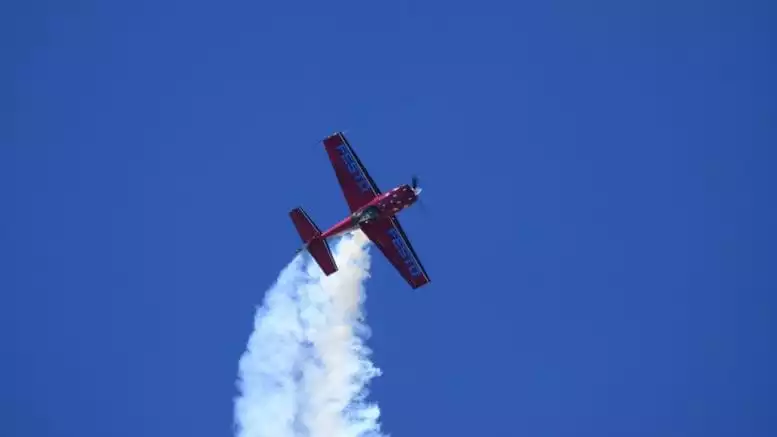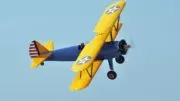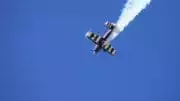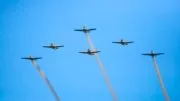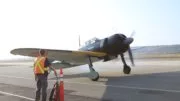What Is the Aerobatic Box and How Does It Affect Air Shows?
The aerobatic box is a three-dimensional cube of air 3281 feet long and 1000 meters wide. Learn everything there is to know about the aerobatic box.
What makes aerobatic competitions and certain air shows even more impressive is the fact that they take place within strict limits. They take place within what’s known as “the aerobatic box,” which limits the space in the sky in which the pilot can maneuver his or her airplane. When the pilot strays from the this area in an aerobatic competition, his or her score suffers. Staying within the aerobatic box demonstrates fine aviation control and awareness of the pilot’s orientation in the sky. To avoid boundary violations, aerobatic pilots must have constant awareness of their speed, the motion of winds and crosswinds, and the physics of how the airplane behaves at various altitudes.
What Is the Aerobatic Box?
The aerobatic box is a three-dimensional cube of air which is 3281 feet long and a thousand meters wide. The other dimensions of the box depend on which category and what kind of aircraft the pilot is flying.
The aerobatic box consists of a buffer zone of 164 feet on two sizes, along the X and Y axes. This location depends on the direction of the wind; the Y axis is along the crosswind, and the X axis is along the wind. Before the competition, pilots are given a chart of the box dimensions along with the latitude and longitude coordinates of its boundaries.
The judges of the competition sit at what is usually oriented as the “bottom” of the box, and the boundaries of it are measured relative to their location. The judges sit with a buffer of five hundred to eight hundred feet. They are generally parallel to the X axis and facing the geometric center of the aerobatic box. A safety buffer zone of one nautical mile is also drawn around the operating area so that other aircraft traffic and spectators are protected.
Volunteers designated as “boundary judges” use binoculars or some other device to ensure that the participants stay within these areas. At the Le Bourget Paris Air Show, the aerobatic box is patrolled by tanks on either end of the airfield, both of which train radar on the dimensions in which the pilots must perform. This data is downloaded and shared with the pilot and his or her team. It eliminates questions about what a human volunteer might have seen or not seen regarding boundary violations.
Upper and Lower Limits of the Aerobatic Box
Here are the upper limits and are expressed as AGL, or “above ground level”:
- 3,280 AGL: Unlimited (Power)
- 3,609 AGL: Advanced (Power)
- 3,500 AGL: All Other Power Categories
- 3,937 AGL: Unlimited and Advanced (Glider)
- 4,000 AGL: All Other Glider Categories
There are the same number of categories for the lower limits of the aerobatic box:
- 1,500 AGL: Primary and Sportsman (Power and Glider)
- 1,200 AGL: Intermediate (Power and Glider)
- 656 AGL: Advanced (Power and Glider)
- 656 AGL: Unlimited (Glider)
- 328 AGL: Unlimited (Power)
These areas for airshows are temporarily established for an aerobatic competition event. Some are located at an airport, and others are placed at remote locations for spectator safety.
Practicing in the Aerobatic Box
If the aerobatic boxes for air shows and aerobatic competitions are temporary, how do the pilots practice? The Federal Aviation Administration (FAA) has strict rules about where and when aerobatic airplanes may perform. Here’s what the FAA has to say in its Federal Aviation Regulations (FAR 91.303):
“No person may operate an aircraft in aerobatic flight
(a) Over any congested area of a city, town or settlement
(b) Over an open-air assembly of persons
(c) Within the lateral boundaries of the surface area of Class B, Class C, Class D, or Class E airspace designated for an airport
(d) Within four nautical miles of the center line of any federal airway
(e) Below an altitude of 1,500 feet above the surface; or
(f) When flight visibility is less than three statute miles.”
These restrictions are in place for the safety of those on the ground, as well as to keep federal airways clear. The rule about flight visibility is for the safety of not only the practicing aerobatic pilot, but also those in airplanes which might cross over the airspace. It’s not safe to practice in low visibility. Such rules also help to limit noise from aerobatic airplanes as they practice maneuvers which bring them close to the ground.
Generally, aerobatic pilots make sure to fly above fifteen hundred feet AGL to get some practice in. It is important for them to watch carefully for other aircraft before attempting a maneuver. In the context of an air show, sometimes the Air Boss will contact the pilot via radio if the pilot is wavering.
Waivered to the Surface
Professional aerobatic pilots, however, need constant access to a safe and dependable area while developing a new routine or learning a new maneuver, especially when these parts of their performance involve bringing the airplane close to the ground.
With this, pilots who are parts of air shows are taught to rehearse their performance even lower than necessary in the event that sudden changes in weather or maintenance issues bring them closer to the ground than usual. The sight of the ground rushing up faster than expected, or seeming disconcertingly closer than usual, can cause the pilot to pull up the nose of the airplane at the wrong time or make panicked decisions. This means the pilots need to work with an aerobatic box which is “waivered to the surface.’
Conclusion
The FAA is aware that this particular “piece” of airspace can contain pilots performing aerobatic maneuvers. It is possible for these pilots to work in permanent aerobatic boxes. Each box is “owned” by a person who is responsible for monitoring it.
The problem, however, is finding one. The FAA does not seem to keep a searchable database of permanent aerobatic boxes. However, the International Aerobatic Club is usually helpful in assisting pilots to find a place to rehearse. At the next air show, remember to think about what you have learned today and everything that goes into air show acrobatics!
Ready to Soar with Us?

